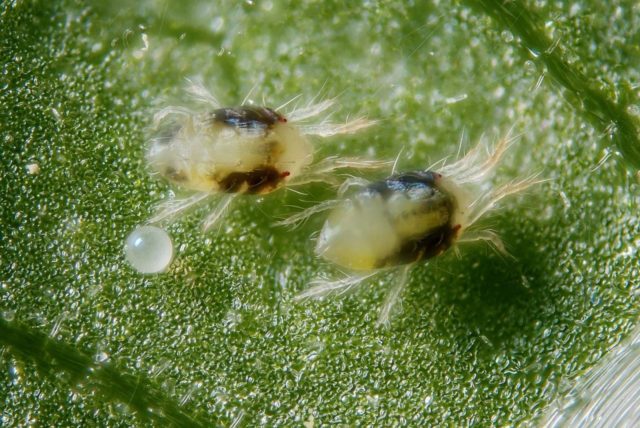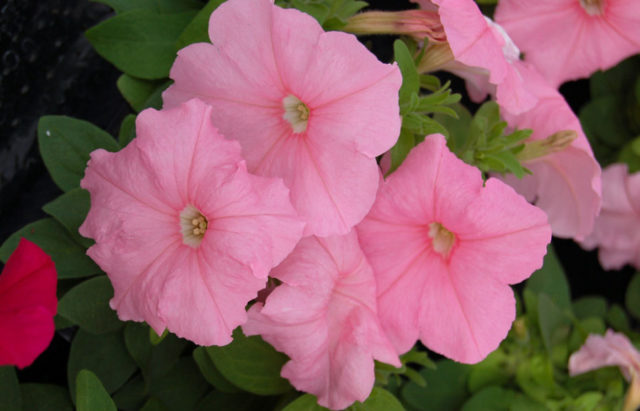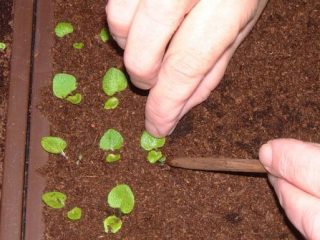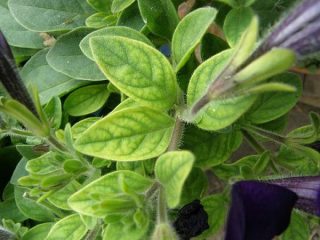Content
- 1 History of selection
- 2 Description of the Mambo petunia variety and characteristics
- 3 Petunia varieties
- 4 Advantages and disadvantages of the variety
- 5 Reproduction methods
- 6 Growing and care
- 7 Pests and diseases
- 8 Application in landscape design
- 9 Conclusion
- 10 Reviews with photos about multi-flowered petunia Mambo F1
Petunia Mambo (Mambo F1) is a low-growing multi-flowered variety of crop that has gained wide popularity among gardeners. And the variety of colors of its flowers only contributes to this. The hybrid is highly resistant to adverse weather conditions, as well as pests and diseases.
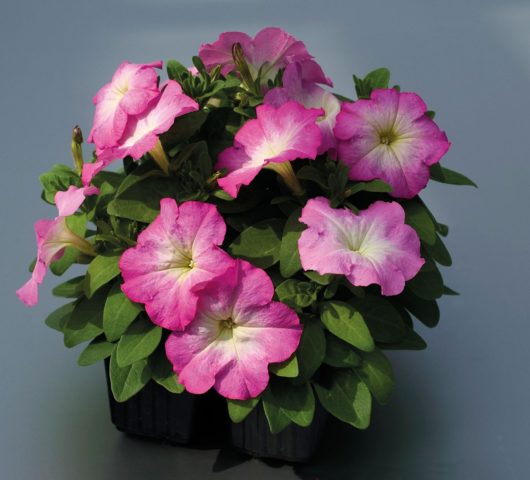
Mambo is characterized by abundant flowering throughout the season
History of selection
Until the middle of the last century, all varieties of petunias were presented in only three main colors: white, pink and purple. At the same time, the bushes were not particularly decorative or compact. But soon everything changed.
The originator of the Mambo series is the Dutch company Hem Genetics, which was founded in 1998.It was thanks to the efforts of its employees that a multi-stage selection of petunia was carried out, which made it possible to obtain new hybrid forms of this crop. Dwarf species with numerous buds and high resistance to adverse factors have become a real breakthrough. These include the Mambo series, which was launched at the beginning of the 20th century.
Description of the Mambo petunia variety and characteristics
Petunia Mambo, like other types of crops, belongs to the Solanaceae family, so it is a close relative of tomatoes and potatoes. The varieties of this series are distinguished by low-growing, spreading bushes that do not lose their shape throughout the season.
The plant is characterized by round, branched shoots, the height of which does not exceed 30 cm. They can be creeping or erect, depending on the variety. The leaves of Petunia Mambo are sessile, simple, and arranged alternately on the stems. The shade of the plates varies from light to dark green.
Petunia Mambo's flowers are shaped like a gramophone. They consist of five petals fused together. When fully opened, their diameter varies from 6 to 9 cm. At the base of the flowers there are five connected sepals, on the surface of which you can see a thick edge. The buds of Petunia Mambo are single, they grow from the axils of the leaves and have short petioles. The color of the flowers is very diverse.

The Mambo series includes both single-color and two-color types
The buds of the varieties of this series are elongated and elongated.They form at an accelerated pace, giving the impression of continuous flowering. The whole process lasts about 5 days, not a week like other species.
The root system of Petunia Mambo is powerful and well developed. They are rod-shaped with a huge number of adventitious processes, which provide the above-ground part with all the nutrients and water.
These crop varieties are moisture-loving, but do not tolerate prolonged stagnation of water in the soil. In this case, Mambo petunia may be affected by fungal diseases. It also easily tolerates temperature changes. And can withstand short-term cold snaps of up to +10 degrees.
According to reviews and photos, when grown, Mambo petunia forms a flower ball, on which the foliage is practically invisible due to the numerous buds.
Petunia varieties
This series includes many species. Some of them are characterized by large flowers, others by small ones, but at the same time they form a huge number of them. To understand the diversity of this hybrid form, you should consider some varieties separately in order to get a complete picture of them.
Petunia Mambo F1 Burgundy
Mambo F1 Burgundy is a fast-growing compact annual variety. Forms lush bushes no more than 30 cm high. Despite its small size, the shrub forms numerous buds that completely cover the foliage. This variety of petunia requires regular plucking of the tops of the stems. The color of the flower is monochromatic, dark cherry, reminiscent of wine, which served as the name.

When fully opened, the diameter of the flowers of the Mambo F1 Burgundy variety reaches 8 cm
Petunia multiflora Mambo GP
A new variety belonging to the multiflora category. This petunia is characterized by small flowers of a rich purple hue. Their diameter does not exceed 6 cm. The height of the bushes reaches 20 cm. A distinctive feature is the preservation of short stature throughout the entire growing season.

Petunia variety Mambo GP is weather resistant
Petunia Mambo purple
An unpretentious variety that can withstand short-term drought without loss of decorativeness. Suitable for growing in balcony boxes and open ground. The plant retains its shape throughout the season and does not stretch. The height of the bushes of Mambo purple petunia reaches 25-30 cm. The color of the flowers is uniform, deep purple. The diameter when the buds are fully opened is 7-8 cm.

Petunia Mambo purple belongs to the category of early flowering species
Petunia multiflora Mambo F1 white
This dwarf petunia hybrid does not require growth regulation. It forms compact spreading bushes 20-25 cm high. Petunia multiflora Mambo F1 white is characterized by numerous flowers, the diameter of which does not exceed 6 cm. They retain a bright shade throughout the entire life cycle.

Petunia variety Mambo white is resistant to rain
Mambo F1 red
This species belongs to the large-flowered category, but is one of the first to bloom. The bush is compact, the length of the shoots is 20 cm. The shade of the gramophone flowers is rich red, which noticeably makes it stand out from the rest. The diameter of the buds when fully opened is 9 cm.

Petunia Mambo F1 red is characterized by continuous flowering for three months
Mambo F1 GP Orchid Wayned
A new variety belonging to the multiflora category.The height of the bush does not exceed 15-20 cm. It is distinguished by the spectacular color of its flowers. The main tone is pink, but dark veins are clearly visible on it, which extend from the center of the gramophone. The diameter of the flowers reaches 6 cm.

Mambo F1 GP Orchid Vined is suitable for growing in containers and open ground
Mambo F1 Rose
An early flowering dwarf variety of this series. "Rose" is characterized by abundant flowering throughout the season. The height of the bushes reaches 20-25 cm. The color of the flower is coral-pink, monochromatic with a light center. Their diameter is 8 cm.

Petunia Mambo F1 Rose is low susceptible to diseases
Mambo Red Morning
A two-color variety of low-growing petunia with a stable habit throughout the season. The height of the branched shrub does not exceed 25-30 cm. The shoots are densely leafy. The flowers have a wide pink-red border around the edges, and the middle of the gramophone is a light cream shade with a bright yellow center. This gives a special contrast to this look.

The diameter of the flowers of the Mambo Red Morning variety is 7-8 cm
Advantages and disadvantages of the variety
The Mambo petunia series has a number of advantages, which makes it one of the most popular among gardeners. But it also has disadvantages that you should pay attention to so that later it does not become an unpleasant surprise.

The key to successful cultivation of Mambo petunia is high-quality seeds
Main advantages:
- short stature of bushes;
- numerous buds;
- preservation of decorativeness throughout the season;
- various colors of flowers;
- resistance to adverse weather conditions;
- does not require growth regulators;
- early flowering;
- accelerated rate of growth of green mass;
- does not require complex care.
The disadvantages include:
- the collected seeds do not retain the species properties of the series;
- requires increased feeding;
- the flowers don't smell;
- needs good lighting;
- difficult cultivation at an early stage;
- sensitive to stagnation of moisture in the soil.
Reproduction methods
Petunia of the Mambo series can be propagated vegetatively and by seeds. But if you choose the latter, you need to purchase planting material annually to preserve varietal qualities. Sowing should be done at the end of February.
This series is easily propagated by apical cuttings. To do this, you need to cut parts of the shoots with 5-6 leaves. Remove the bottom plates completely. Plant the seedlings at a distance of 2 cm from each other in a moist, loose substrate. There is no need to cover the top with film to prevent the cuttings from rotting. Keep the soil slightly moist at all times. Rooting occurs in 1-2 weeks. After this, it is necessary to transplant the seedlings into separate containers and pinch them over the 4th leaf.
Growing and care
The process of growing Mambo petunias is labor-intensive, but entertaining. Therefore, you need to be patient. For sowing, you should prepare wide containers with drainage holes no higher than 7 cm. They should be filled with loose nutrient substrate, watered generously and the surface leveled. Place the seeds on top. Then cover the containers with film and move them to a bright place with a temperature of +23-25 degrees. Shoots appear on days 5-7.

Petunia germinates in the light, so you can’t sprinkle the seeds with soil.
When growing, you need to provide 12 hours of daylight and moderate watering as needed. When the seedlings become stronger, they need to be planted in separate containers. And after 10 days, fertilize with nitrogen fertilizers.
Petunia Mambo should be transplanted to a permanent place in a pot or open ground at an air temperature of at least +18 degrees. Each plant should have 3-4 liters of substrate. Petunia Mambo should be planted at a distance of 25 cm so that the plants fully develop and do not compete for food.
Further care consists of regular watering as the top layer of soil dries, avoiding stagnation of moisture. To do this you need to use distilled water. You should also fertilize every 10 days using phosphorus-potassium fertilizers.
Pests and diseases
If the growing conditions are not appropriate and the care rules are not followed, this crop can be affected by pests and diseases. Therefore, it is necessary to promptly respond to any alarming signs, otherwise the plant may die.
Common problems:
- Late blight. The disease manifests itself when there are sudden changes in temperature between day and night for a long time. Characteristic features are a brown tint of leaves and shoots. For prevention and treatment, Ridomil Gold should be used.
- Powdery mildew. It can be recognized by a light, thick coating on the leaves, which subsequently spreads to the shoots and flowers. This leads to disruption of metabolic processes in tissues and premature aging.For treatment you need to use "Skor".
- Chlorosis. The disease in Petunia Mambo develops when there is a lack of iron in the soil. It is characterized by a light shade of leaves with dark green veins. For treatment you need to use Iron Chelate.
- Spider mite. A small pest that becomes more active during periods of drought and heat. You can identify it on Mambo petunias by the dejected appearance of the bushes, scanty flowering and a thin cobweb on the tops of the shoots. To destroy, use Actellik.
- Thrips. Small brown insects that can be found on leaves. They feed on plant sap, which leads to deformation of shoots and plates. To fight, you should use Inta-Vir.
Application in landscape design
Petunia Mambo is widely used for landscaping areas, balconies, terraces and gazebos. Its compact flowering bushes allow you to add bright accents to your garden. This series is suitable for the foreground of multi-level compositions.
It goes well with alyssum and lobelia. The plant can also be planted in balcony boxes and flowerpots.
Conclusion
Petunia Mambo is a spectacular series with compact, profusely flowering bushes. It became a serious breakthrough in the selection of this crop. The variety of shades of its colors allows you to give free rein to your imagination and create bright compositions using single-color and two-color types that will delight throughout the season.



